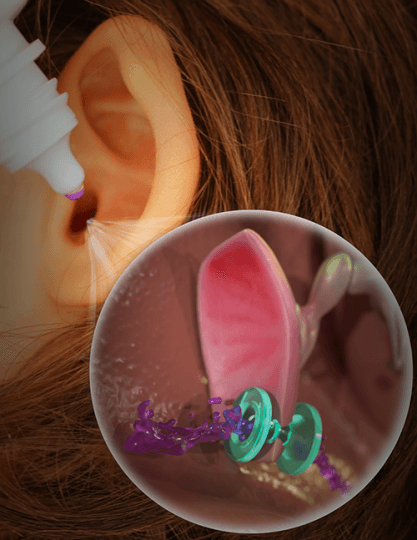新しいイヤーチューブにより、耳感染症患者の治療成績が向上 Novel ear tubes improve treatment outcomes for patients with ear infections
2023-04-06 ハーバード大学

Collaborating researchers at Harvard’s Wyss Institute and School of Engineering and Applied Sciences, and Mass Eye and Ear in Boston have developed a blueprint for designing optimized tympanostomy tubes and other fluid-transporting devices. The approach combines antifouling liquid-infused materials with optimized geometries to achieve new functionalities at a small scale. Credit: Second Bay Studio
一般的な鼓膜切開チューブは50年以上前の技術を用いており、薬剤の伝達が十分でなく、浸透圧バリアを乗り越えることができず、定期的な手術の必要性があります。しかし、新しい鼓膜切開チューブは機能が改善され、細胞の付着が減少し、中耳への選択的な液体輸送が向上し、薬剤の送達も可能になりました。この新しい技術は、中耳炎の患者の治療を劇的に改善する可能性があります。
<関連情報>
- https://seas.harvard.edu/news/2023/04/creating-blueprint-optimized-ear-tubes-and-other-implantable-fluid-transporting
- https://www.science.org/doi/10.1126/scitranslmed.add9779
選択的な流体輸送特性を有する医療用鼓膜瘻コンジットの設計 Design of medical tympanostomy conduits with selective fluid transport properties
Haritosh Patel,Ida Pavlichenko,Alison Grinthal,Cathy T. Zhang,Jack Alvarenga,Michael J. Kreder,James C. Weaver,Qin Ji,Christopher W. F. Ling,Joseph Choy,Zihan Li,Nicole L. Black,Paulo J. M. Bispo,Jennifer A. Lewis,Elliott D. Kozin,Joanna Aizenberg and Aaron K. Remenschneider
Science Translational Medicine Published:5 Apr 2023
DOI:https://doi.org/10.1126/scitranslmed.add9779
Abstract
Implantable tubes, shunts, and other medical conduits are crucial for treating a wide range of conditions from ears and eyes to brain and liver but often impose serious risks of device infection, obstruction, migration, unreliable function, and tissue damage. Efforts to alleviate these complications remain at an impasse because of fundamentally conflicting design requirements: Millimeter-scale size is required to minimize invasiveness but exacerbates occlusion and malfunction. Here, we present a rational design strategy that reconciles these trade-offs in an implantable tube that is even smaller than the current standard of care. Using tympanostomy tubes (ear tubes) as an exemplary case, we developed an iterative screening algorithm and show how unique curved lumen geometries of the liquid-infused conduit can be designed to co-optimize drug delivery, effusion drainage, water resistance, and biocontamination/ingrowth prevention in a single subcapillary–length-scale device. Through extensive in vitro studies, we demonstrate that the engineered tubes enabled selective uni- and bidirectional fluid transport; nearly eliminated adhesion and growth of common pathogenic bacteria, blood, and cells; and prevented tissue ingrowth. The engineered tubes also enabled complete eardrum healing and hearing preservation and exhibited more efficient and rapid antibiotic delivery to the middle ear in healthy chinchillas compared with current tympanostomy tubes, without resulting in ototoxicity at up to 24 weeks. The design principle and optimization algorithm presented here may enable tubes to be customized for a wide range of patient needs.


